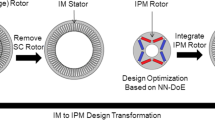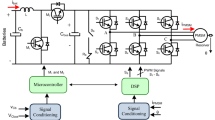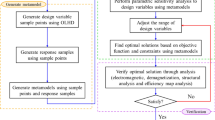Abstract
This study proposes an optimal design using artificial neural network models to improve the efficiency of a 15 kW-class interior permanent magnet synchronous motor (IPMSM) used in micro electric vehicles (EVs). The proposed method improves the efficiency of the initial IPMSM model by combining the number of poles and slots as well as the shape design of the rotor. The number of poles used and the combination of slots were determined according to the purpose of the micro-EV motor, the windings of the stator were changed from distributed winding to concentrated winding, and the dimensions of the rotor were selected to maximize efficiency. We realize the optimal design was performed with using a model with having a structure of a concentrated winding stator 18-slot rotor12-poles in the IPMSM having with a distributed winding stator 48-slot rotor 8-pole structure as an initial model. The objective function and constraints were determined for the optimal design and as a metamodel, we applied recurrent neural network and long short-term memory models. The optimal metamodel was selected by comparing the root-mean-square error test results according to the efficiency and cogging torque characteristics to evaluate its accuracy. We validate the optimal design result derived based on the proposed shape-optimization method through finite element analysis. An optimal model of the 15 kW-class IPMSM prototype used in micro-EVs was designed for validation. The efficiency performance improved by 1.6%, as validated through a motor dynamo test.























Similar content being viewed by others
Data availability
The data sets generated during the current study are available from the corresponding author on reasonable request.
References
Ahn K, Bayrak A, Papalambros P (2015) Electric vehicle design optimization: integration of a high-fidelity interior-permanent-magnet motor model. IEEE Trans Veh Technol 64(9):3870–3877. https://doi.org/10.1109/TVT.2014.2363144
Ashfaq M, Butt O, Selvaraj J, Rahim N (2021) Assessment of electric vehicle charging infrastructure and its impact on the electric grid: a review. Int J Green Energy 18(7):657–686. https://doi.org/10.1080/15435075.2021.1875471
Baek S (2018) Optimum shape design of a BLDC motor for electric continuous variable valve timing system considering efficiency and torque characteristics. Microsyst Technol 24(11):4441–4452. https://doi.org/10.1007/s00542-018-3991-2
Baek S, Lee S (2020) Design optimization and experimental verification of permanent magnet synchronous motor used in electric compressors in electric vehicles. Appl Sci 10(9):3235. https://doi.org/10.3390/app10093235
Bhagubai P, Bucho L, Fernandes J, Costa Branco P (2022) Optimal design of an interior permanent magnet synchronous motor with cobalt iron core. Energies 15(8):2882. https://doi.org/10.3390/en15082882
Breban S, Dranca M, Chirca M, Pacuraru A, Teodosescu P, Oprea C (2022) Experimental tests on a spoke-type permanent magnets synchronous machine for light electric vehicle application. Appl Sci 12:3019. https://doi.org/10.3390/app12063019
Cai S, Lau V (2021) RNN-based learning of nonlinear dynamic system using wireless IIoT networks. IEEE Internet Things J 8(14):11177–11192. https://doi.org/10.1109/JIOT.2021.3052925
Chai F, Liang P, Cheng PY, S, (2015) Analytical method for iron losses reduction in interior permanent magnet synchronous motor. IEEE Trans Magn 51(11):1–4. https://doi.org/10.1109/TMAG.2015.2453164
Chen S, Song B, Guo J (2018) Attention alignment multimodal LSTM for fine-gained common space learning. IEEE Access 6:20195–20208. https://doi.org/10.1109/ACCESS.2018.2822663
Chen Z, Yang C, Qiao J (2022) The optimal design and application of LSTM neural network based on the hybrid coding PSO algorithm. J Supercomput 78:7227–7259. https://doi.org/10.1007/s11227-021-04142-3
Fatemi A, Ionel D, Popescu M, Chong Y, Demerdash N (2018) Design optimization of a high torque density spoke-type PM motor for a Formula E race drive cycle. IEEE Trans Ind Appl 54:4343–4354. https://doi.org/10.1109/TIA.2018.2844804
Franzese G, Visintin M (2020) Probabilistic ensemble of deep information networks. Entropy (basel, Switzerland) 22(1):100. https://doi.org/10.3390/e22010100
Gong J, Gillon F, Canh J, Xu Y (2017) Proposal of a kriging output space mapping technique for electromagnetic design optimization. IEEE Trans Magn 53(6):1–4. https://doi.org/10.1109/TMAG.2017.2666263
Jiang W, Feng S, Zhang Z, Zhang J, Zhang Z (2018) Study of efficiency characteristics of interior permanent magnet synchronous motors. IEEE Trans Magn 54(11):1–5. https://doi.org/10.1109/TMAG.2018.2847328
Lee S, Jung W, Bae D, Lee M (2020) A study on the application of hollow p-eps to a micro-electric vehicle using a simulator. Trans Korean Soc Autom Eng 28(12):875–882. https://doi.org/10.7467/KSAE.2020.28.12.875
Lee H, Kim J, Seo S, Sim M, Kim J (2022) Exploring behaviors and satisfaction of micro-electric vehicle sharing service users: evidence from a demonstration project in Jeju Island. South Korea. Sustain Cities Soc 79:103673. https://doi.org/10.1016/j.scs.2022.103673
Li Z, Khajepour A, Song J (2019) A comprehensive review of the key technologies for pure electric vehicles. Energy 182:824–839. https://doi.org/10.1016/j.energy.2019.06.077
Muzir N, Mojumder M, Hasanuzzaman M, Selvaraj J (2022) Challenges of electric vehicles and their prospects in Malaysia: a comprehensive review. Sustainability 14:8320. https://doi.org/10.3390/su14148320
Piggot G, Verkuijl C, Van Asselt H, Lazarus M (2020) Curbing fossil fuel supply to achieve climate goals. Clim Policy 20(8):881–887. https://doi.org/10.1080/14693062.2020.1804315
Rind S, Ren Y, Hu Y, Wang J, Jiang L (2017) Configurations and control of traction motors for electric vehicles: a review. Chin J Electr Eng 3(3):1–17. https://doi.org/10.23919/CJEE.2017.8250419
Schaltz E, Stroe D, Nørregaard K, Ingvardsen L, Christensen A (2021) Incremental capacity analysis applied on electric vehicles for battery state-of-health estimation. IEEE Trans Ind Appl 57(2):1810–1817. https://doi.org/10.1109/TIA.2021.3052454
Taniar D, Safar M, Tran Q, Rahayu W, Park J (2011) Spatial network RNN queries in GIS. Comput J 54(4):617–627. https://doi.org/10.1093/comjnl/bxq068
Wang Z, Ching T, Huang S, Wang H, Xu T (2021) Challenges faced by electric vehicle motors and their solutions. IEEE Access 9:5228–5249. https://doi.org/10.1109/ACCESS.2020.3045716
Yan C, Zhu J, Shen X, Fan J, Mi D, Qian Z (2020) Ensemble of regression-type and interpolation-type metamodels. Energies 13(3):654. https://doi.org/10.3390/en13030654
Yang L, Ho S, Fu W, Liu L (2016) A mesh deformation algorithm and its application in optimal motor design. IEEE Trans Magn 52(3):1–4. https://doi.org/10.1109/TMAG.2015.2490249
Yoon K, Baek S (2019) Robust design optimization with penalty function for electric oil pumps with BLDC motors. Energies 12(1):153. https://doi.org/10.3390/en12010153
Acknowledgements
This research was funded by a 2021 Research Grant from Sangmyung University (2021-A000-0267).
Author information
Authors and Affiliations
Corresponding author
Additional information
Publisher's Note
Springer Nature remains neutral with regard to jurisdictional claims in published maps and institutional affiliations.
Rights and permissions
Springer Nature or its licensor (e.g. a society or other partner) holds exclusive rights to this article under a publishing agreement with the author(s) or other rightsholder(s); author self-archiving of the accepted manuscript version of this article is solely governed by the terms of such publishing agreement and applicable law.
About this article
Cite this article
Kim, HJ., Baek, SW. Optimal design of a 15 kW-class interior permanent magnet synchronous motor for micro-EV traction using artificial neural network models. Microsyst Technol 29, 1165–1179 (2023). https://doi.org/10.1007/s00542-023-05471-4
Received:
Accepted:
Published:
Issue Date:
DOI: https://doi.org/10.1007/s00542-023-05471-4




